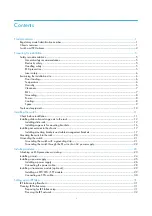
38
Connecting hosts
Four servers/multiple switches/SAN fabric
Figure 24
Connecting hosts: switch attach—four servers/multiple switches/SAN fabric
Connecting remote management hosts
The management host directly manages systems out-of-band over an Ethernet network.
1.
Connect an RJ-45 Ethernet cable to the network management port on each MSA 2040 controller.
2.
Connect the other end of each Ethernet cable to a network that your management host can access
(preferably on the same subnet).
NOTE:
Connections to this device must be made with shielded cables—grounded at both ends—with
metallic RFI/EMI connector hoods, in order to maintain compliance with NEBS and FCC Rules and
Regulations.
Connecting two storage systems to replicate volumes
Remote Snap replication is a licensed disaster-recovery feature that performs asynchronous (batch)
replication of block-level data from a volume on a local (primary) storage system to a volume that can be
on the same system or a second, independent system. The second system can be located at the same site
as the first system, or at a different site.
The two associated standard volumes form a replication set, and only the primary volume (source of data)
can be mapped for access by a server. Both systems must be licensed to use Remote Snap, and must be
connected through switches to the same fabric or network (i.e., no direct attach). The server accessing the
replication set need only be connected to the primary system. If the primary system goes offline, a
connected server can access the replicated data from the secondary system.
Replication configuration possibilities are many, and can be cabled—in switch attach fashion—to support
MSA 2040 SAN systems on the same network, or on different networks (MSA 2040 SAS systems do not
support replication). As you consider the physical connections of your system—specifically connections for
replication—keep several important points in mind:
•
Ensure that controllers have connectivity between systems, whether local or remote.
•
Assign specific ports for replication whenever possible. By specifically assigning ports available for
replication, you free the controller from scanning and assigning the ports at the time replication is
performed.
6Gb/s
S
S
A
6Gb/s
S
S
A
Server 1
Server 2
SAN
Server 3
Server 4
MSA 2040 SAN
Summary of Contents for MSA 2040
Page 8: ...8 Figures ...
Page 10: ...10 Tables ...
Page 32: ...32 Installing the enclosures ...
Page 44: ...44 Connecting hosts ...
Page 50: ...50 Connecting to the controller CLI port ...
Page 52: ...52 Basic operation ...
Page 70: ...70 Troubleshooting ...
Page 74: ...74 Support and other resources ...
Page 76: ...76 Documentation feedback ...
Page 88: ...88 LED descriptions ...
Page 94: ...94 Electrostatic discharge ...
Page 100: ...100 Index ...





































